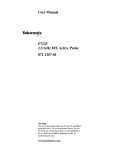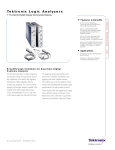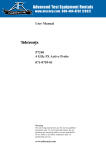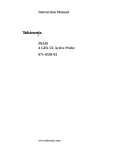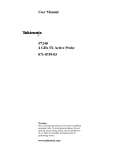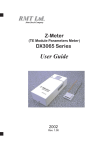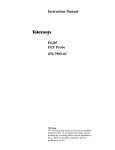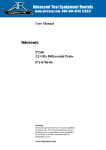Download Manual - TRS RenTelco
Transcript
Instructions P6243 1 GHz 10X Active Probe 070-9408-03 www.tektronix.com Copyright E Tektronix, Inc. All rights reserved. Tektronix products are covered by U.S. and foreign patents, issued and pending. Information in this publication supercedes that in all previously published material. Specifications and price change privileges reserved. Tektronix, Inc., P.O. Box 500, Beaverton, OR 97077 TEKTRONIX, TEK, TEKPROBE, and SureFoot are registered trademarks of Tektronix, Inc. KlipChip is a trademark of Tektronix. Inc. WARRANTY Tektronix warrants that the products that it manufactures and sells will be free from defects in materials and workmanship for a period of one (1) year from the date of shipment. If a product proves defective during this warranty period, Tektronix, at its option, either will repair the defective product without charge for parts and labor, or will provide a replacement in exchange for the defective product. In order to obtain service under this warranty, Customer must notify Tektronix of the defect before the expiration of the warranty period and make suitable arrangements for the performance of service. Customer shall be responsible for packaging and shipping the defective product to the service center designated by Tektronix, with shipping charges prepaid. Tektronix shall pay for the return of the product to Customer if the shipment is to a location within the country in which the Tektronix service center is located. Customer shall be responsible for paying all shipping charges, duties, taxes, and any other charges for products returned to any other locations. This warranty shall not apply to any defect, failure or damage caused by improper use or improper or inadequate maintenance and care. Tektronix shall not be obligated to furnish service under this warranty a) to repair damage resulting from attempts by personnel other than Tektronix representatives to install, repair or service the product; b) to repair damage resulting from improper use or connection to incompatible equipment; c) to repair any damage or malfunction caused by the use of non-Tektronix supplies; or d) to service a product that has been modified or integrated with other products when the effect of such modification or integration increases the time or difficulty of servicing the product. THIS WARRANTY IS GIVEN BY TEKTRONIX IN LIEU OF ANY OTHER WARRANTIES, EXPRESS OR IMPLIED. TEKTRONIX AND ITS VENDORS DISCLAIM ANY IMPLIED WARRANTIES OF MERCHANTABILITY OR FITNESS FOR A PARTICULAR PURPOSE. TEKTRONIX’ RESPONSIBILITY TO REPAIR OR REPLACE DEFECTIVE PRODUCTS IS THE SOLE AND EXCLUSIVE REMEDY PROVIDED TO THE CUSTOMER FOR BREACH OF THIS WARRANTY. TEKTRONIX AND ITS VENDORS WILL NOT BE LIABLE FOR ANY INDIRECT, SPECIAL, INCIDENTAL, OR CONSEQUENTIAL DAMAGES IRRESPECTIVE OF WHETHER TEKTRONIX OR THE VENDOR HAS ADVANCE NOTICE OF THE POSSIBILITY OF SUCH DAMAGES. Table of Contents General Safety Summary . . . . . . . . . . . . . . . . . . . . . . . . . . . . iii Getting Started . . . . . . . . . . . . . . . . . . . . . . . . . . . . . . . . . . . . . Customer Support . . . . . . . . . . . . . . . . . . . . . . . . . . . . . . . . . . . Features and Accessories . . . . . . . . . . . . . . . . . . . . . . . . . . . . . . Configuration . . . . . . . . . . . . . . . . . . . . . . . . . . . . . . . . . . . . . . . Functional Check or Probe Compensation . . . . . . . . . . . . . . . . 1 1 2 6 6 Operating Basics . . . . . . . . . . . . . . . . . . . . . . . . . . . . . . . . . . . Maximum Non-destructive Input Voltage . . . . . . . . . . . . . . . . . Input Linear Dynamic Range . . . . . . . . . . . . . . . . . . . . . . . . . . Ground Lead Length . . . . . . . . . . . . . . . . . . . . . . . . . . . . . . . . . Probe Tip Test Points . . . . . . . . . . . . . . . . . . . . . . . . . . . . . . . . . 9 9 9 10 14 Specifications . . . . . . . . . . . . . . . . . . . . . . . . . . . . . . . . . . . . . . 15 P6243 Instructions i Table of Contents List of Figures Figure 1: Probe Compensation Connections . . . . . . . . . . . . . . . Figure 2: Waveform Distortion from Ground Lead Length . . . Figure 3: Ground Lead Equivalent Circuit . . . . . . . . . . . . . . . . Figure 4: Low-inductance Grounding . . . . . . . . . . . . . . . . . . . . Figure 5: Using a SureFoot Adapter for Grounding . . . . . . . . . Figure 6: Using a Probe Tip as a Test Point . . . . . . . . . . . . . . . Figure 7: Typical Frequency Response . . . . . . . . . . . . . . . . . . . Figure 8: Typical Linearity Error vs. VIN . . . . . . . . . . . . . . . . . Figure 9: Typical Input Impedance vs. Frequency . . . . . . . . . . Figure 10: Typical Non-Destructive Peak Voltage Derating vs. Frequency . . . . . . . . . . . . . . . . . . . . . . . . . . . . . . . . . . . . . . . ii 7 10 11 12 13 14 17 18 19 20 P6243 Instructions General Safety Summary Review the following safety precautions to avoid injury and prevent damage to this product or any products connected to it. Only qualified personnel should perform service procedures. Injury Precautions Avoid Electric Overload. To avoid electric shock or fire hazard, do not apply a voltage to a terminal that is outside the range specified for that terminal. Do Not Operate Without Covers. To avoid electric shock or fire hazard, do not operate this product with covers or panels removed. Do Not Operate in Wet/Damp Conditions. To avoid electric shock, do not operate this product in wet or damp conditions. Do Not Operate in an Explosive Atmosphere. To avoid injury or fire hazard, do not operate this product in an explosive atmosphere. Product Damage Precautions Use Proper Power Source. Do not operate this product from a power source that applies more than the voltage specified. Do Not Operate With Suspected Failures. If you suspect there is damage to this product, have it inspected by qualified service personnel. Do Not Immerse in Liquids. Clean the probe using only a damp cloth. The cloth must be dampened with either isopropyl alcohol or a mild detergent and water solution. Do not use any other chemicals or abrasives to clean the probe. P6243 Instructions iii General Safety Summary Safety Terms and Symbols Terms in This Manual. These terms may appear in this manual: WARNING. Warning statements identify conditions or practices that could result in injury or loss of life. CAUTION. Caution statements identify conditions or practices that could result in damage to this product or other property. Terms on the Product. These terms may appear on the product: DANGER indicates an injury hazard immediately accessible as you read the marking. WARNING indicates an injury hazard not immediately accessible as you read the marking. CAUTION indicates a hazard to property including the product. Symbols on the Product. These symbols may appear on the product: DANGER High Voltage iv Protective Ground (Earth) Terminal ATTENTION Refer to Manual Double Insulated P6243 Instructions Getting Started The Tektronix P6243 is a 1 GHz, 10X active FET probe with less than 1 pF input capacitance. The low input capacitance and high input resistance of the probe minimize circuit loading over a wide bandwidth. The probe has a small profile and low-mass that makes probing crowded circuits fast and easy. The accessory tips and adapters allow for a wide variety of circuit connections. The P6243 Active Probe obtains power from the host oscilloscope through the TEKPROBE interface. For oscilloscopes and instruments that do not have the TEKPROBE interface, use the optional Tektronix 1103 Probe Power Supply. For service information, including part numbers of standard and optional accessories, refer to the P6243 Service Manual (070-9409-XX). Customer Support To help you get the best performance from your probe, Tektronix offers the following customer support: Using Your Probe If you need assistance using your probe, please call 1-800-TEKWIDE (1-800-835-9433) and ask for the Customer Support Center. If you are outside the United States or Canada, please contact your nearest Tektronix Service Center. Servicing Your Probe For service and service related questions, please contact your nearest Tektronix Service Center. P6243 Instructions 1 Getting Started Features and Accessories The P6243 Active Probe has features and accessories to make probing and measurement a simpler task. Please take a moment to familiarize yourself with these items and their uses. Probe Head Assembly — The probe head is designed for ease of use and high performance. Its small size makes it easy to handle in tight areas. Probe Tip Socket Ground Socket The probe tip socket is sized to easily press onto 0.025 inch pins for direct access. The ground socket provides a short ground path for high fidelity ground connections. TEKPROBE Interface — The TEKPROBE interface provides power, signal, and probe characteristic data transfer. If your oscilloscope does not support the TEKPROBE interface, you can use the optional 1103 probe power supply as an effective interface. Contact your local Tektronix representative for more information. Push-in Probe Tip — Use the push-in probe tip for general purpose probing by hand. The tip may also be used as a temporary test point. See page 14 for more information. Push-In Probe Tip 2 The push-in probe tip may also be used with the other socketed leads and adapters. P6243 Instructions Getting Started Installing the Push-in Probe Tip — Attach the push-in probe tip by seating the tip into the probe tip socket and pushing the tip in until it is seated. Either end of the tip may be used. Do not force the tip. Also, be careful not to poke yourself with the sharp probe-tip. To remove the tip, gently grab the tip with small pliers and pull the tip out. Right-angle adapter — Use the right-angle adapter for low-profile probing of 0.025-inch diameter square pins. The right-angle adapter allows the P6243 to lie flat against a circuit board. This enables probing in vertical circuits such as computer or communications backplanes, or in tight areas such as between circuit cards. The right-angle adapter can be used directly with the probe head, or attached to the Y-lead adapter Right Angle or ground leads. Adapter The right-angle adapter is attached the same way as the push-in probe tip, and can be easily removed by hand. Y-lead Adapter “Y-lead” adapter— Use the Y-lead adapter to extend the physical reach of the probe and ground when necessary. The Y-lead adapter accepts any of the probe tips or adapters, and can be pushed directly onto 0.025 inch pins. When selecting the grounding connection, maintain as short a ground path as possible. Refer to page 10 for more information. To attach the Y-lead adapter, gently press the lead pins into the probe head tip and ground receptacles. Using the black lead for ground is recommended. P6243 Instructions 3 Getting Started 3 and 6 inch ground leads— Use the threeand six-inch ground leads for general probing. The socketed end of the leads may be connected to any of the probe tips and adapters, or fitted onto 0.025 inch pins. To attach the ground leads, press and rotate the lead pin connector into the ground socket on the probe head. The lead may be removed by simply pulling the pin out by hand. When selecting the grounding connection, maintain as short a ground path as possible. Refer to page 10 for more information. Low-inductance ground lead— Use the low-inductance ground adapter to substantially reduce ground lead inductance. Because the ground lead simply touches the ground reference, you can easily move the probe to different points on the device under test. To attach, press the ground lead into the probe-head ground socket. When selecting the grounding connection, maintain as short a ground path as possible. Refer to page 10 for more information. Signal- Ground Adapter — The signal-ground adapter is ideal for use with signal/ground pairs on 0.100 inch header pins (such as FlexLead adapters). Attach the signal-ground adapter by gently pressing it into the ground socket on the probe head. FlexLead Adapter Signal Ground Adapter 4 P6243 Instructions Getting Started SMT KlipChip — Use the SMT KlipChip test clips to access fragile, dense circuitry. KlipChip KlipChip test clips connect to the Y-lead or threeor six-inch ground leads. Simply press the lead socket into the KlipChip handle. Y-lead Adapter The KlipChip body freely turns, allowing better probe orientation. To reduce stress and provide a lower profile on components being tested, the flexible sleeve of the KlipChip bends up to a 35 degree angle. Color Marker Bands Color Marker Bands — Attach matching pairs of the color marker bands onto the cable at the head and compensation box of each probe. The marker bands enable quick verification of which probe is connected to which instrument channel. SureFoot probe tip (optional) — The SureFoot tip is an integral probe tip and miniature guide that enables fault-free probing of fine-pitch SMD packages. Attach the SureFoot adapters the same way as the push-in probe tips. They can be used with any of the socketed accessory leads. SF502 -- The blue SureFoot tip is compatible with 0.025 inch JEDEC and 0.65 mm EIAJ packages. SF503 -- The red SureFoot tip is compatible with 0.5 mm EIAJ packages. P6243 Instructions 5 Getting Started Configuration The P6243 Active Probe provides the oscilloscope with the probe model number, serial number, and attenuation factor. When connected to a TEKPROBE oscilloscope, display readouts are corrected for the probe attenuation factor, the instrument input is set to 50 Ω, and the coupling is set to DC. CAUTION. Do not attempt to install the P6243 Active Probe on a non-TEKPROBE connector. Damage to the probe and connector may result. If your oscilloscope does not support the TEKPROBE interface, use the optional Tektronix 1103 Probe Power Supply. If the P6243 Active Probe is used with the Tektronix 1103 Probe Power Supply, be sure to have a 50 Ω termination at the oscilloscope. Also, set the oscilloscope channel coupling to DC. Functional Check or Probe Compensation After installing the probe on the oscilloscope, perform a functional check or compensate the probe using the PROBE COMPENSATION connections on the front panel of the oscilloscope. See Figure 1. (The ground connection is not necessary for a functional check.) NOTE. You can compensate the probe only if your oscilloscope supports the TEKPROBE interface and has a calibration routine for that purpose. For instructions, refer to the user manual of your oscilloscope. 6 P6243 Instructions Getting Started Figure 1: Probe Compensation Connections 1. Connect the probe to the oscilloscope. 2. Set the oscilloscope to display the probe channel. 3. If you intend to compensate the probe, connect a ground lead and an SMT KlipChip to the GND terminal. 4. Using a standard tip, hold the probe to the SIGNAL terminal. 5. Press AUTOSET (or adjust the oscilloscope) to display the waveform specified for the compensation output. 6. If you intend to compensate the probe, refer to the user manual for your oscilloscope and perform the calibration routine now. 7. Disconnect the probe tip from the SIGNAL terminal and connect it to the GND terminal. The oscilloscope display should be at the ground reference. P6243 Instructions 7 Getting Started 8 P6243 Instructions Operating Basics Please follow these operating guidelines to get optimum performance from your P6243 Active Probe. Maximum Non-destructive Input Voltage The P6243 Active Probe is electrically protected against static voltage; however, applying voltages above its design limits may damage the probe tip amplifier. Please refer to the Specifications section of this manual for the maximum non-destructive input voltage and frequency derating information. Input Linear Dynamic Range The probe head amplifier used by the P6243 Active Probe has a limited linear operating range. To keep the input linearity error less than 4% you must limit the signal input voltage to ±8 V (DC + peak AC). NOTE. The probe can tolerate input voltages of ±15 V without damage; however, the linearity error specification does not apply to input voltages exceeding ±8 V (DC + peak AC). P6243 Instructions 9 Operating Basics Ground Lead Length When you are probing a circuit, you should always use as short a ground lead as possible between the probe head and circuit ground. The input capacitance of the P6243 and the inductance of the ground lead results in a resonant circuit that can ring. Using a shorter ground lead will minimize ringing. See Figure 2. Low-inductance Ground Three-inch Ground Six-inch Ground Figure 2: Waveform Distortion from Ground Lead Length Figure 3 illustrates the resistance, capacitance, and inductance that the probe and ground lead adds to a circuit. 10 P6243 Instructions Operating Basics R source Probe R in 1 MΩ V source Probe C in 1 pF L gl (Ground Lead) Figure 3: Ground Lead Equivalent Circuit You can determine if ground lead effects may be a problem in your application if you know the inductance (L) of the ground lead and input capacitance (C) of the probe. Calculate the approximate resonant frequency (f0) at which this parasitic circuit will resonate with the following formula: f0 = 1 2π LC The preceding equation shows that reducing the ground lead inductance will raise the resonant frequency. If your measurements are affected by ringing, your goal is to lower the inductance of your ground path until the resulting resonant frequency is well above the frequency of your measurements. P6243 Instructions 11 Operating Basics Low-inductance Grounding Placing a ground plane on top of a package being probed can minimize ground lead length and inductance. See Figure 4. Figure 4: Low-inductance Grounding Attach a thin piece of copper on top of the package and connect it to the package ground connection. Use the low-inductance ground lead provided with the probe to keep the ground lead length as short as possible. This method is very useful when making many measurements on the same package. Using a ground plane on the package makes probing the package easier, and avoids adding unnecessary ground lead length. 12 P6243 Instructions Operating Basics SureFoot Grounding If you cannot use the low-inductance grounding method recommended, the probe may be grounded to the package under test using a SureFoot adapter. Refer to Figure 5. Figure 5: Using a SureFoot Adapter for Grounding P6243 Instructions 13 Operating Basics Probe Tip Test Points The push-in probe tip or a 0.025 square pin can be soldered into a circuit to be used as a temporary test point. See Figure 6. Solder the tip onto a lead or pin with a low-power soldering iron. Press the probe head onto the tip to make a measurement, and then pull the probe head off when you are done. The probe tip may be removed and reused by desoldering it from the circuit, and soldering it into another circuit in the future. Solder Figure 6: Using a Probe Tip as a Test Point NOTE. It is not recommended that pieces of solid-core copper wire be used as test points. If the wire breaks off in the probe tip socket, it may be impossible to remove the wire, and it will prevent insertion of other accessory tips. 14 P6243 Instructions Specifications The warranted specifications in Table 1 apply to a P6243 Active Probe when the probe and the host instrument are allowed to warm up for 20 minutes before measurements are taken. The warranted specifications that appear in boldface type are specifications checked in the Performance Verification section of the service manual. The specifications in Tables 2 through 5 are provided as general information for your convenience. CAUTION. Do not apply voltages beyond the non-destructive input voltage range to the probe. Damage to the probe or circuit under test may result. Refer to Figure 10. Table 1: Warranted Electrical Specifications Analog Bandwidth (probe only) at +20°C to +30°C (+68°F to +86°F) >1.0 GHz DC Attenuation Accuracy (probe only) at +20°C to +30°C (+68°F to +86°F) 10:1 ±2% Output Zero at +20°C to +30°C (+68°F to +86°F) ±10 mV or less at output of probe Rise Time (probe only) at +20°C to +30°C (+68°F to +86°F) <350 ps P6243 Instructions ±100 mV or less displayed on screen with TEKPROBE interface 15 Specifications Table 2: Typical Electrical Characteristics Frequency Response (probe only) See Figure 7 Linear Input Dynamic Range -- 8 V to + 8 V. (Equivalent to -- 0.8 V to + 0.8 V at the output of the probe) Linearity 4% or less of dynamic range Linearity Error vs. VIN See Figure 8 Input Resistance 1 MΩ at DC. (See Figure 9) Input Capacitance <1.0 pF Non-Destructive Input Voltage Range -- 15 V to + 15 V (DC + peak AC) (See Figure 10) DC Offset Drift 100 V/°C or less at output of probe 1 mV/°C or less displayed on screen with TEKPROBE interface Delay Time 16 5.3 ns ±0.2 ns P6243 Instructions Specifications +2 dB +1 dB 0 dB - 1 dB - 2 dB - 3 dB - 4 dB - 5 dB - 6 dB - 7 dB - 8 dB 1 MHz 10 MHz 100 MHz 1 GHz Figure 7: Typical Frequency Response P6243 Instructions 17 Specifications 150 mV 100 mV Display Error 50 mV 0 mV - 50 mV - 100 mV - 150 mV - 20 V - 10 V 0V VIN 10 V 20 V Figure 8: Typical Linearity Error vs. VIN 18 P6243 Instructions Specifications 10 MΩ 1 MΩ 100 kΩ 10 kΩ 1 kΩ 100 Ω 10 Ω 100 Hz 1 kHz 10 kHz 100 kHz 1 MHz 10 MHz 100 MHz 1 GHz Figure 9: Typical Input Impedance vs. Frequency P6243 Instructions 19 Specifications 25 V 20 V 15 V 10V at 1 GHz 10 V 6V at 3 GHz 5V 0V 1 MHz 10 MHz 100 MHz 1 GHz Figure 10: Typical Non-Destructive Peak Voltage Derating vs. Frequency 20 P6243 Instructions Specifications Table 3: Physical Characteristics Net Weight 63.8 g (2.25 ounces) Cable Length 1.3 meter (4.3 ft) Table 4: Environmental Characteristics Operating Temperature 0°C to +50°C (+32°F to +122°F) The environmental exposure is the procedure stated in Tektronix Design Standard 062--2847--00 for Class 5 equipment Non-operating Temperature -- 40°C to + 71°C (-- 40°F to + 160°F) The environmental exposure is the procedure stated in Tektronix Design Standard 062--2847--00 for Class 5 equipment Humidity The environmental exposure is the procedure stated in Tektronix Design Standard 062--2847--00 for Class 5 equipment Packaged Product Vibration and Shock The packaged product qualifies under the Distribution Cycle 1 Assurance Level II for packaged products 0 -- 20 lbs. Test 2 for Warehouse and Vehicle Stacking (Compression) is omitted Tektronix standard 062--2858--00, Rev. B, Class 5 Altitude P6243 Instructions Operating: 4,572 m (15,000 ft) Non--Operating: 15,240 m (50,000 ft) 21 Specifications Table 5: Certifications and Compliances EC Declaration of Conformity Meets the intent of Directive 89/336/EEC for Electromagnetic Compatibility. Compliance was demonstrated to the following specifications as listed in the official Journal of the European Communities: EN 50081--1 Emissions: EN 55022 FCC Compliance 22 EN 60555--2 Class B: Radiated and Conducted Emissions Power Harmonics EN 50082--1 Immunity: IEC 801--2 IEC 801--3 IEC 801--4 IEC 801--5 Electrostatic Discharge RF Radiated Fast Transients Surge Emissions comply with FCC Code of Federal Regulations 47 CFR, Part 15, Subpart B, Class A P6243 Instructions

































